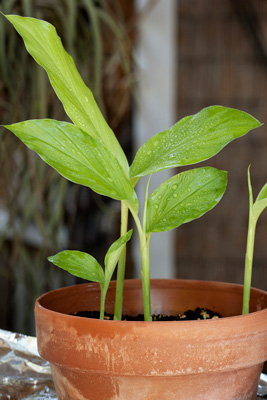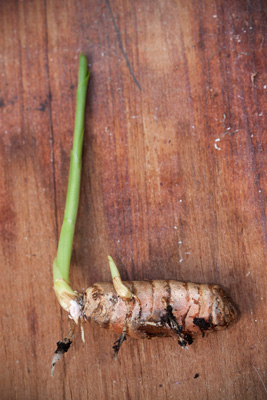If you have difficulty finding turmeric rhizomes, try an Indian or Asian market, or the Internet — but buy from a reputable online source.
Now to propagate: Place your rhizomes just below the surface of the soil. If you see some peeking through the soil, that’s fine. If your rhizomes have any buds or green growth, make sure the growth is facing toward the top.
I planted mine in a shallow but wide pot and used shredded coconut coir as the potting medium. You can buy coir as a compressed brick to which you add water. It’s often mixed with soil to aid in maintaining moisture and avoiding compaction. I also placed some rhizomes into a compost and soil mixture, but the plants in the pure coir have so far outgrown their counterparts in soil.
The first leafy growth shot up after about six weeks in coir, which was kept fairly moist. I keep it facing east on a shelf at the edge of my patio, so that it receives strong morning light and warmth, but is shielded from direct sun from about noon onward. I tried growing some rhizomes in bright shade, but they haven’t been nearly as vigorous as those that received some direct sun.
When you see the delicate new shoots start to unfurl their leaves and reach a few inches tall, you can think about putting your turmeric in the ground or into a larger pot. They eventually reach three or so feet tall.
I’m still searching for an ideal spot, keeping in mind turmeric likes sun, but they need consistent moisture; these are not drought-tolerant plants. I’m considering a spot just beyond the edge of a roof to catch runoff. In winter they’ll go dormant and require far less water.
When planting them in the ground, place them so that the rhizome is a couple inches below ground. I plan to replace much of the surrounding soil with compost to nurture the transplants and the original coconut coir to improve drainage.
In summer, you can feed hungry plants bi-monthly with an organic fertilizer. In winter, turmeric rhizomes can stay outdoors in South Florida and where there is no risk of freezing. Otherwise, store them indoors in pots of soil or similar dry conditions, avoiding the refrigerator, which can dehydrate.
Turmeric will take about 10 months to mature. Gently dig around in the soil and you will find the rhizomes have spread. These can be removed and used to grow more turmeric or eaten as you would ginger. Making the powdered turmeric spice requires boiling the rhizome for 45 minutes, peeling and drying them for about a week before pulverizing. Be aware the peeled or cut rhizomes will stain your fingers deep yellow.
Turmeric has been used as a dye, spice and medicine for thousands of years. What isn’t certain is how it may be medicinally effective. Western medicine demands quantifiable data as evidence, and I can’t see drug companies funding a study that might show we can grow our own treatments. But online information — much from questionable sources — shows it is used as everything from an antibacterial to an antidepressant, though more and more reputable scientists are researching the pharmacology of turmeric.



